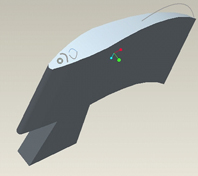Morphing Blades Can Be More Efficient than Rigid Blades
 In wind turbine operation, airflow separation causes turbulence, which diminishes blade efficiency. It is therefore desirable to limit or eliminate flow separation. Many passive or active separation control mechanisms have been proposed to reduce separation. Active control systems sense the wind velocity or rotational speed, and modify blade aerodynamic configurations accordingly. Some propose employing suction within the boundary layer. Others suggest particle blow-through leading edge slots and use of trailing edge flaps. Passive vortex generators have also been proposed. Generally, all such control schemes improve the blade performance at part-load, but they also reduce blade efficiency at or near the design load. Further, in the case of active control, they come at the cost of an added power penalty as well as design complications. The use of morphing blades, however, eliminates flow separation without design point penalties.
In wind turbine operation, airflow separation causes turbulence, which diminishes blade efficiency. It is therefore desirable to limit or eliminate flow separation. Many passive or active separation control mechanisms have been proposed to reduce separation. Active control systems sense the wind velocity or rotational speed, and modify blade aerodynamic configurations accordingly. Some propose employing suction within the boundary layer. Others suggest particle blow-through leading edge slots and use of trailing edge flaps. Passive vortex generators have also been proposed. Generally, all such control schemes improve the blade performance at part-load, but they also reduce blade efficiency at or near the design load. Further, in the case of active control, they come at the cost of an added power penalty as well as design complications. The use of morphing blades, however, eliminates flow separation without design point penalties.
By Asfaw Beyene, Department of Mechanical Engineering, San Diego State University, USA .
 In wind turbine operation, airflow separation causes turbulence, which diminishes blade efficiency. It is therefore desirable to limit or eliminate flow separation. Many passive or active separation control mechanisms have been proposed to reduce separation. Active control systems sense the wind velocity or rotational speed, and modify blade aerodynamic configurations accordingly. Some propose employing suction within the boundary layer. Others suggest particle blow-through leading edge slots and use of trailing edge flaps. Passive vortex generators have also been proposed. Generally, all such control schemes improve the blade performance at part-load, but they also reduce blade efficiency at or near the design load. Further, in the case of active control, they come at the cost of an added power penalty as well as design complications. The use of morphing blades, however, eliminates flow separation without design point penalties.
In wind turbine operation, airflow separation causes turbulence, which diminishes blade efficiency. It is therefore desirable to limit or eliminate flow separation. Many passive or active separation control mechanisms have been proposed to reduce separation. Active control systems sense the wind velocity or rotational speed, and modify blade aerodynamic configurations accordingly. Some propose employing suction within the boundary layer. Others suggest particle blow-through leading edge slots and use of trailing edge flaps. Passive vortex generators have also been proposed. Generally, all such control schemes improve the blade performance at part-load, but they also reduce blade efficiency at or near the design load. Further, in the case of active control, they come at the cost of an added power penalty as well as design complications. The use of morphing blades, however, eliminates flow separation without design point penalties.By Asfaw Beyene, Department of Mechanical Engineering, San Diego State University, USA .